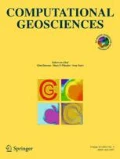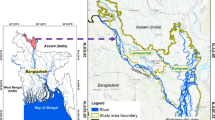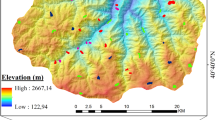Abstract
Land cover classification is one of the most important applications of POLSAR images. In this paper, a hybrid biogeography-based optimization support vector machine (HBBOSVM) has been introduced to classify POLSAR images of RADARSAT 2 in band C acquired from San Francisco, USA. The main purpose of this classification is to minimize the number of features and maximize classification accuracy. The proposed method consists of three main steps: preprocessing, feature selection and classification. As preprocessing, radiometric calibration, speckle reduction and feature extraction have been performed. In the proposed HBBO, the combination of onlooker bee of artificial bee colony (ABC) and migration operator of biogeography-based optimization has been applied in order to optimal feature selection. Then, SVM has been used to classify the pixels into specific labels of land-covers. The ground truth samples have been generated by google earth image, Pauli RGB image, high resolution image and national land cover database (NLCD 2006). The performance of HBBOSVM has been compared with BBOSVM, ABCSVM, particle swarm optimization support vector machine (PSOSVM) and the results of previous studies. In addition, the performance of HBBO is evaluated upon 20 well-known benchmark problems. According to the obtained results, the overall accuracy and average accuracy of HBBOSVM are 96.01% and 93.37% respectively which is the best result in comparison with other results. The HBBOSVM has better performance than other algorithms in terms of overall accuracy, kappa coefficient, average accuracy, convergence trend, and stability. In addition, the HBBO can be considered as a successful meta-heuristic for benchmark problems. This paper displays that the combined approach of optimization and machine learning methods provides powerful results.
Similar content being viewed by others
References
Du, P., Samat, A., Waske, B., Liu, S., Li, Z.: Random forest and rotation forest for fully polarized SAR image classification using polarimetric and spatial features. ISPRS J. Photogramm. Remote Sens. 105, 38–53 (2015)
Samat, A., Gamba, P., Liu, S., Miao, Z., Li, E., Abuduwaili, J.: Quad-PolSAR data classification using modified random forest algorithms to map halophytic plants in arid areas. Int. J. Appl. Earth Obs. Geoinf. 73, 503–521 (2018)
Salehi, M., Sahebi, M.R., Maghsoudi, Y.: Improving the accuracy of urban land cover classification using Radarsat-2 PolSAR data. IEEE J. Sel. Top. Appl. Earth Obs. Remote Sens. 7(4), 1394–1401 (2013)
Hänsch, R., Hellwich, O.: Skipping the real world: classification of PolSAR images without explicit feature extraction. ISPRS J. Photogramm. Remote Sens. 140, 122–132 (2018)
Li, S., Wu, H., Wan, D., Zhu, J.: An effective feature selection method for hyperspectral image classification based on genetic algorithm and support vector machine. Knowl.-Based Syst. 24(1), 40–48 (2011)
Yang, H.C., Zhang, S.B., Deng, K.Z., Du, P.J.: Research into a feature selection method for hyperspectral imagery using PSO and SVM. J. China Univ. Min. Technol. 17(4), 473–478 (2007)
Qi, C., Zhou, Z., Sun, Y., Song, H., Hu, L., Wang, Q.: Feature selection and multiple kernel boosting framework based on PSO with mutation mechanism for hyperspectral classification. Neurocomputing. 220, 181–190 (2017)
Xie, F., Li, F., Lei, C., Yang, J., Zhang, Y.: Unsupervised band selection based on artificial bee colony algorithm for hyperspectral image classification. Appl. Soft. Comput. 75, 428–440 (2019)
Medjahed, S.A., Saadi, T.A., Benyettou, A., Ouali, M.: Gray wolf optimizer for hyperspectral band selection. Appl. Soft. Comput. 40, 178–186 (2016)
Ghosh, A., Datta, A., Ghosh, S.: Self-adaptive differential evolution for feature selection in hyperspectral image data. Appl. Soft. Comput. 13(4), 1969–1977 (2013)
Wang, M., Wu, C., Wang, L., Xiang, D., Huang, X.: A feature selection approach for hyperspectral image based on modified ant lion optimizer. Knowl.-Based Syst. 168, 39–48 (2019)
Mahdianpari, M., Salehi, B., Mohammadimanesh, F., Brisco, B., Mahdavi, S., Amani, M., Granger, J.E.: Fisher linear discriminant analysis of coherency matrix for wetland classification using PolSAR imagery. Remote Sens. Environ. 206, 300–317 (2018)
Liu, F., Shi, J., Jiao, L., Liu, H., Yang, S., Wu, J., Yuan, J.: Hierarchical semantic model and scattering mechanism based PolSAR image classification. Pattern Recogn. 59, 325–342 (2016)
Qi, Z., Yeh, A.G.O., Li, X., Zhang, X.: A three-component method for timely detection of land cover changes using polarimetric SAR images. ISPRS J. Photogramm. Remote Sens. 107, 3–21 (2015)
Maghsoudi, Y., Collins, M., Leckie, D.G.: Polarimetric classification of boreal forest using nonparametric feature selection and multiple classifiers. Int. J. Appl. Earth Obs. Geoinf. 19, 139–150 (2012)
Shokrollahi, M., Ebadi, H.: Improving the accuracy of land cover classification using fusion of polarimetric SAR and hyperspectral images. J. Indian Soc. Remote Sens. 44(6), 1017–1024 (2016)
Leardi, R.: Genetic algorithms in feature selection. In: Devillers, J. (ed.) Genetic algorithms in molecular modeling, pp. 67–86. Academic Press, London (1996)
Kohavi, R., John, G.H.: Wrappers for feature subset selection. Artif. Intell. 97(1–2), 273–324 (1997)
Leardi, R., Gonzalez, A.L.: Genetic algorithms applied to feature selection in PLS regression: how and when to use them. Chemom. Intell. Lab. Syst. 41(2), 195–207 (1998)
Somol, P., Pudil, P., Novovičová, J., Paclık, P.: Adaptive floating search methods in feature selection. Pattern Recogn. Lett. 20(11–13), 1157–1163 (1999)
Inza, I., Larrañaga, P., Etxeberria, R., Sierra, B.: Feature subset selection by Bayesian network-based optimization. Artif. Intell. 123(1–2), 157–184 (2000)
Inza, I., Merino, M., Larrañaga, P., Quiroga, J., Sierra, B., Girala, M.: Feature subset selection by genetic algorithms and estimation of distribution algorithms: a case study in the survival of cirrhotic patients treated with TIPS. Artif. Intell. Med. 23(2), 187–205 (2001)
Zhang, H., Sun, G.: Feature selection using Tabu search method. Pattern Recogn. 35(3), 701–711 (2002)
Chen, X.W.: An improved branch and bound algorithm for feature selection. Pattern Recogn. Lett. 24(12), 1925–1933 (2003)
Zhu, F., Guan, S.: Feature selection for modular GA-based classification. Appl. Soft Comput. 4(4), 381–393 (2004)
Tsymbal, A., Pechenizkiy, M., Cunningham, P.: Diversity in search strategies for ensemble feature selection. Inf. Fusion. 6(1), 83–98 (2005)
Paterlini, S., Krink, T.: Differential evolution and particle swarm optimisation in partitional clustering. Comput. Stat. Data Anal. 50(5), 1220–1247 (2006)
Wang, X., Yang, J., Teng, X., Xia, W., Jensen, R.: Feature selection based on rough sets and particle swarm optimization. Pattern Recogn. Lett. 28(4), 459–471 (2007)
Huang, C.L., Dun, J.F.: A distributed PSO–SVM hybrid system with feature selection and parameter optimization. Appl. Soft Comput. 8(4), 1381–1391 (2008)
Nemati, S., Basiri, M.E., Ghasem-Aghaee, N., Aghdam, M.H.: A novel ACO–GA hybrid algorithm for feature selection in protein function prediction. Expert Syst. Appl. 36(10), 12086–12094 (2009)
Vieira, S.M., Sousa, J.M., Runkler, T.A.: Two cooperative ant colonies for feature selection using fuzzy models. Expert Syst. Appl. 37(4), 2714–2723 (2010)
Pourhabibi, T., Imani, M.B., Haratizadeh, S.: Feature selection on Persian fonts: a comparative analysis on GAA, GESA and GA. Procedia Comput. Sci. 3, 1249–1255 (2011)
Kabir, M.M., Shahjahan, M., Murase, K.: A new hybrid ant colony optimization algorithm for feature selection. Expert Syst. Appl. 39(3), 3747–3763 (2012)
Vieira, S.M., Mendonça, L.F., Farinha, G.J., Sousa, J.M.: Modified binary PSO for feature selection using SVM applied to mortality prediction of septic patients. Appl. Soft Comput. 13(8), 3494–3504 (2013)
Nazir, M., Majid-Mirza, A., Ali-Khan, S.: PSO-GA based optimized feature selection using facial and clothing information for gender classification. J. Appl. Res. Technol. 12(1), 145–152 (2014)
Sanz-García, A., Fernández-Ceniceros, J., Antonanzas-Torres, F., Pernia-Espinoza, A.V., Martinez-de-Pison, F.J.: GA-PARSIMONY: a GA-SVR approach with feature selection and parameter optimization to obtain parsimonious solutions for predicting temperature settings in a continuous annealing furnace. Appl. Soft Comput. 35, 13–28 (2015)
Hancer, E., Xue, B., Karaboga, D., Zhang, M.: A binary ABC algorithm based on advanced similarity scheme for feature selection. Appl. Soft Comput. 36, 334–348 (2015)
Ghaemi, M., Feizi-Derakhshi, M.R.: Feature selection using forest optimization algorithm. Pattern Recogn. 60, 121–129 (2016)
Sheikhpour, R., Sarram, M.A., Sheikhpour, R.: Particle swarm optimization for bandwidth determination and feature selection of kernel density estimation based classifiers in diagnosis of breast cancer. Appl. Soft Comput. 40, 113–131 (2016)
Pashaei, E., Aydin, N.: Binary black hole algorithm for feature selection and classification on biological data. Appl. Soft Comput. 56, 94–106 (2017)
Zhang, Y., Song, X.F., Gong, D.W.: A return-cost-based binary firefly algorithm for feature selection. Inf. Sci. 418, 561–574 (2017)
Gunasundari, S., Janakiraman, S., Meenambal, S.: Multiswarm heterogeneous binary PSO using win-win approach for improved feature selection in liver and kidney disease diagnosis. Comput. Med. Imaging Graph. 70, 135–154 (2018)
Prasad, Y., Biswas, K.K., Hanmandlu, M.: A recursive PSO scheme for gene selection in microarray data. Appl. Soft Comput. 71, 213–225 (2018)
Tao, Z., Huiling, L., Wenwen, W., Xia, Y.: GA-SVM based feature selection and parameter optimization in hospitalization expense modeling. Appl. Soft Comput. 75, 323–332 (2019)
García-Nieto, P.J., García-Gonzalo, E., Fernández, J.A., Muñiz, C.D.: Modeling of the algal atypical increase in La Barca reservoir using the DE optimized least square support vector machine approach with feature selection. Math. Comput. Simul. 166, 461–480 (2019)
Engelbrecht, A.P., Grobler, J., Langeveld, J.: Set based particle swarm optimization for the feature selection problem. Eng. Appl. Artif. Intell. 85, 324–336 (2019)
Yu, J.: Manifold regularized stacked denoising autoencoders with feature selection. Neurocomputing. 358, 235–245 (2019)
Esfandiarpour-Boroujeni, I., Karimi, E., Shirani, H., Esmaeilizadeh, M., Mosleh, Z.: Yield prediction of apricot using a hybrid particle swarm optimization-imperialist competitive algorithm-support vector regression (PSO-ICA-SVR) method. Sci. Hortic. 257, 108756 (2019)
Taradeh, M., Mafarja, M., Heidari, A.A., Faris, H., Aljarah, I., Mirjalili, S., Fujita, H.: An evolutionary gravitational search-based feature selection. Inf. Sci. 497, 219–239 (2019)
Cao, L., Li, J., Zhou, Y., Liu, Y., Liu, H.: Automatic feature group combination selection method based on GA for the functional regions clustering in DBS. Comput. Methods Prog. Biomed. 183, 105091 (2020)
Abdel-Basset, M., El-Shahat, D., El-henawy, I., de Albuquerque, V.H.C., Mirjalili, S.: A new fusion of grey wolf optimizer algorithm with a two-phase mutation for feature selection. Expert Syst. Appl. 139, 112824 (2020)
Abd Elaziz, M., Ewees, A.A., Ibrahim, R.A., Lu, S.: Opposition-based moth-flame optimization improved by differential evolution for feature selection. Math. Comput. Simul. 168, 48–75 (2020)
Yazdani, S., Shanbehzadeh, J., Aminian, E.: Feature subset selection using constrained binary/integer biogeography-based optimization. ISA Trans. 52(3), 383–390 (2013)
Srivastava, A., Ghosh, S., Anantharaman, N., Jayaraman, V.K.: Hybrid biogeography based simultaneous feature selection and MHC class I peptide binding prediction using support vector machines and random forests. J. Immunol. Methods. 387(1–2), 284–292 (2013)
Tu, Q., Chen, X., Liu, X.: Multi-strategy ensemble grey wolf optimizer and its application to feature selection. Appl. Soft Comput. 76, 16–30 (2019)
Emary, E., Zawbaa, H.M., Hassanien, A.E.: Binary grey wolf optimization approaches for feature selection. Neurocomputing. 172, 371–381 (2016)
Simon, D.: Biogeography-based optimization. IEEE Trans. Evol. Comput. 12(6), 702–713 (2008)
Gutierrez, J.C.T., Adamatti, D.S., Bravo, J.M.: A new stopping criterion for multi-objective evolutionary algorithms: application in the calibration of a hydrologic model. Comput. Geosci. 23(6), 1219–1235 (2019)
Harb, A., Kassem, H., Ghorayeb, K.: Black hole particle swarm optimization for well placement optimization. Comput. Geosci. 24(6), 1979–2000 (2019)
Lotfy, A., Kaveh, M., Mosavi, M.R., Rahmati, A.R.: An enhanced fuzzy controller based on improved genetic algorithm for speed control of DC motors. Analog Integr. Circ. Sig. Process. 105(2), 141–155 (2020)
Kaveh, M., Kaveh, M., Mesgari, M.S., Paland, R.S.: Multiple criteria decision-making for hospital location-allocation based on improved genetic algorithm. Appl. Geomatics 12(3), 291–306 (2020)
Kaveh, M., Mesgari, M.S., Khosravi, A.: Solving the local positioning problem using a four-layer artificial neural network. Eng. J. Geospatial Inf. Technol. 7(4), 21–40 (2020)
Kaveh, M., Mesgari, M.S.: Hospital site selection using hybrid PSO algorithm-case study: district 2 of Tehran. Sci-Res. Q. Geogr. Data (SEPEHR). 28(111), 7–22 (2019)
Kaveh, M., Mesgari, M.S.: Improved biogeography-based optimization using migration process adjustment: an approach for location-allocation of ambulances. Comput. Ind. Eng. 135, 800–813 (2019)
Khishe, M., Mosavi, M.R., Kaveh, M.: Improved migration models of biogeography-based optimization for sonar dataset classification by using neural network. Appl. Acoust. 118, 15–29 (2017)
Kaveh, M., Khishe, M., Mosavi, M.R.: Design and implementation of a neighborhood search biogeography-based optimization trainer for classifying sonar dataset using multi-layer perceptron neural network. Analog Integr. Circ. Sig. Process. 100(2), 405–428 (2019)
Mosavi, M. R., Kaveh, M., & Khishe, M.: Sonar data set classification using MLP neural network trained by non-linear migration rates BBO. In: The fourth Iranian conference on engineering electromagnetic (ICEEM), pp. 1–5. (2016)
Mosavi, M.R., Kaveh, M., Khishe, M., Aghababaee, M.: Design and implementation a sonar data set classifier by using MLP NN trained by improved biogeography-based optimization. In Proceedings of the Second National Conference on Marine Technology, pp. 1–6. (2016)
Bansal, J.C., Farswan, P.: Wind farm layout using biogeography based optimization. Renew. Energy. 107, 386–402 (2017)
Boddula, S., Eldho, T.I.: Groundwater management using a new coupled model of meshless local Petrov-Galerkin method and modified artificial bee colony algorithm. Comput. Geosci. 22(3), 657–675 (2018)
Fattahi, H.: Applying soft computing methods to predict the uniaxial compressive strength of rocks from schmidt hammer rebound values. Comput. Geosci. 21(4), 665–681 (2017)
Vapnik, V.N.: An overview of statistical learning theory. IEEE Trans. Neural Netw. 10(5), 988–999 (1999)
Ben-Hur, A., & Weston, J. (2010). A user’s guide to support vector machines. In: Data mining techniques for the life sciences (pp. 223–239). Humana Press
He, J., Mattis, S.A., Butler, T.D., Dawson, C.N.: Data-driven uncertainty quantification for predictive flow and transport modeling using support vector machines. Comput. Geosci. 23(4), 631–645 (2019)
Tan, F., Luo, G., Wang, D., Chen, Y.: Evaluation of complex petroleum reservoirs based on data mining methods. Comput. Geosci. 21(1), 151–165 (2017)
Deng, L., Yan, Y.N., Wang, C.: Improved POLSAR image classification by the use of multi-feature combination. Remote Sens. 7(4), 4157–4177 (2015)
Ali, M.M., Khompatraporn, C., Zabinsky, Z.B.: A numerical evaluation of several stochastic algorithms on selected continuous global optimization test problems. J. Glob. Optim. 31(4), 635–672 (2005)
Wolpert, D.H., Macready, W.G.: No free lunch theorems for optimization. IEEE Trans. Evol. Comput. 1(1), 67–82 (1997)
Mohammadi, R., Sahebi, M.R., Omati, M., Vahidi, M.: Synthetic aperture radar remote sensing classification using the bag of visual words model to land cover studies. Int. J. Geol. Environ. Eng. 12(9), 588–591 (2018)
Uhlmann, S., Kiranyaz, S.: Integrating color features in polarimetric SAR image classification. IEEE Trans. Geosci. Remote Sens. 52(4), 2197–2216 (2013)
Author information
Authors and Affiliations
Corresponding author
Additional information
Publisher’s note
Springer Nature remains neutral with regard to jurisdictional claims in published maps and institutional affiliations.
Rights and permissions
About this article
Cite this article
Rostami, O., Kaveh, M. Optimal feature selection for SAR image classification using biogeography-based optimization (BBO), artificial bee colony (ABC) and support vector machine (SVM): a combined approach of optimization and machine learning. Comput Geosci 25, 911–930 (2021). https://doi.org/10.1007/s10596-020-10030-1
Received:
Accepted:
Published:
Issue Date:
DOI: https://doi.org/10.1007/s10596-020-10030-1




